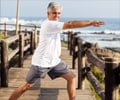Ataxia – a rare genetic neurodegenerative disease can be treated with a combination of deep brain stimulation (DBS) and exercise.

‘Ataxia – a rare genetic neurodegenerative disease characterized by progressive irreversible problems with movement, can be treated with a combination of deep brain stimulation (DBS) and exercise, especially in early-stage ataxia. This provides valuable new insights in designing future DBS strategies to treat the human condition.’





Deep brain stimulation (DBS) is a procedure that involves the regulation of abnormal impulses via implanted electrodes within specified brain regions. It is currently used to relieve motor dysfunction in Parkinson's disease and other movement conditions. However, its feasibility in treating ataxia is yet to be explored completely. The present study utilized a mouse model of hereditary ataxia (Car8) to analyze whether adjusting the parameters of DBS and the stimulation target location would help increase the treatment's efficacy for the condition.
Deep Brain Stimulation in Ataxia
"We first targeted the cerebellum, because it's a primary motor center in the brain and this target location for DBS has seen encouraging success for treating motor problems that are associated with other conditions, such as a stroke. We systematically targeted the cerebellum with different frequencies of DBS and determined whether there was an optimal frequency that would boost the efficacy of the treatment. When we used a particular frequency, 13 Hz, that was when motor function improved in our Car8 mice. We know that exercise, in general, can benefit both muscle and neuronal health, and previous work in Parkinson's disease and stroke patients mentioned that neuromodulation techniques combined with physical stimulation showed benefits, so we decided to include exercise in our investigation", says the first author Lauren Miterko, a graduate student in Dr. Roy Sillitoe's lab at Baylor.
It was observed that induction of DBS during exercise on a treadmill in the mice models at an early stage revealed sustained improvements in motor coordination and stepping even after one week of treatment, that was not observed with DBS alone.
Advertisement
It was also found that a specific group of brain cells called Purkinje cells are demanded for the DBS to be effective as these cells are involved in the process of restoring movement in the ataxia mouse model.
Advertisement
"We are particularly excited about the results of this study because it may be possible to extrapolate our approach for treating not only other motor diseases, but perhaps also non-motor neuropsychiatric conditions," says corresponding author Dr. Roy Sillitoe, associate professor of pathology and immunology and neuroscience at Baylor College of Medicine, and director of the Neuropathology Core facility at the Jan and Dan Duncan Neurological Research Institute of Texas Children's Hospital.
Source-Medindia














